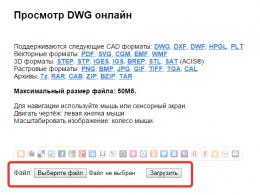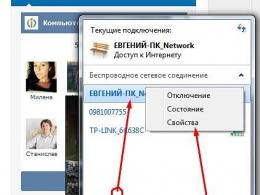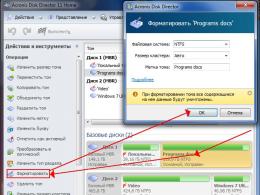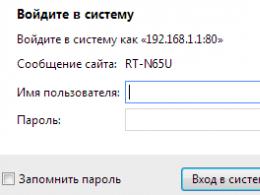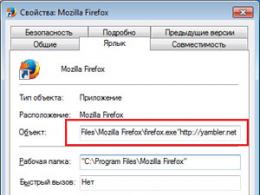Formatting in ntfs windows xp. Format flash drive to ntfs
Most USB flash drives currently in production come with file system FAT32. It is the most versatile file system.
Most devices that have a USB connector will be able to read it.
The main disadvantage is the inability to store documents larger than 4 gigabytes.
This is not critical, unless there is a need to record something larger than 4 GB in size.
The file system NTFS (New Technology File System) will help to perform actions with files of this size. This development is newer than FAT.
Huge maximum size one file.
This is a number with eighteen zeros, so you don't have to worry about exceeding this figure.
A number of multimedia devices do not support the file system (FS) (DVD players, PS3, Xbox 360), but compatibility with PC operating systems is high.
That is, if there is no need to transfer large files, then you don't need to worry about the file system.
And if the need nevertheless arose, then you can format the FS of the flash drive in different ways: with standard tools operating system and using the command line.
Let's consider each of them in more detail.
Formatting a flash drive using Windows
With this method of changing the file system, everything stored on the flash drive will be irretrievably erased.
So it's better to do backup on the HDD PC, if, of course, this is the necessary data. V otherwise you don't have to worry about the contents of the flash drive.
First of all, you need to connect the USB drive itself to the PC. Then in "My Computer" right-click on the flash drive icon.
In the drop-down menu, find the item "Format" and click on it.

The formatting settings window will open. In the drop-down menu, you need to select NTFS, as shown in the image.
No further changes are required. Now you can press the "Start" button.

Before starting the process, the system will once again warn about the permanent deletion of all information from the USB drive.

After confirming the operation, the flash drive will be quickly formatted to NTFS under Windows OS. Upon completion, the file system of the media will be changed.


Format USB flash drive on command line
Note! Formatting a flash drive to NTFS on the command line (using the convert utility) allows you to change the device's file system without losing data. The word "conversion" is more suitable for this process than "formatting".
So, first you need to connect the media to the computer.
Looking into "My Computer", you can find its icon, under it is the volume label assigned to the disk by the system. In this case it is (F:).

For a number of reasons and factors, the volume label can be different. In any case, it must be remembered. Next, you need a command line.
It opens in different versions operating systems in different ways.

Windows 7:
To access the interpreter Windows commands 7, you can use the same method as for the previous OS.
The Start menu, in the Accessories folder, also provides the ability to open a command prompt.

Windows 8:

Openly command line you need to enter the following request: convert F: / FS: NTFS. In place of "F:" you need to enter the volume label of the removable disk that was memorized earlier.
After pressing "Enter", the file system conversion will begin.
No data will be lost in the process. Upon completion, you will get something like this:

As you can see, the system has been changed from FAT32 to NTFS:

And the data is still there:

- Although converting the file system using the command line allows you to save data, play it safe and make backup still stands on the PC hard drive;
- To convert, you need a certain amount of free space on the media. If it is not enough, then the process will not end, and an error message will appear:
« Total on disk: 8006656 KB
Free: 40549 Kb
Required for conversion: 50549 KB
Not enough space to convert
Conversion failure F: has not been converted toNTFS»
To successfully retry the conversion, you will need to free up the missing space by deleting or moving some files. - You need to carefully select the volume label of the device, if you make a mistake and specify a different one, then another disk will be formatted;
- It's best not to format a removable drive if it's frequently used with an obsolete Windows 98;
- It is also better not to format bootable flash drives, otherwise they will no longer be bootable;
- File system change removable media on NTFS will slightly increase the speed of data operations;

Now reformatting the flash drive is not a problem. The main thing to remember is that in most cases you can do without it.
So, for constant interaction with many different multimedia devices, it is better to leave FAT32.
While NTFS improves reliability and durability removable disk, not all devices can interact with this file system.
Let's see how to format a flash drive to the NTFS file system in the Windows operating system without using additional program. The vast majority of modern portable USB flash drives support conversion between multiple file systems.
By default, flash drives usually use the FAT32 file system, because USB drives with the FAT32 file system are supported by most operating systems, a flash drive will work on almost any device.
A feature of the FAT32 file system is that files no larger than 4 GB are not supported. There are situations when you need to download a file larger than 4 GB to a portable drive. The NTFS file system supports files larger than 4 GB.
One way out of this situation is to format the flash drive from the FAT32 file system to the NTFS file system. Please note that along with the pluses, a flash drive in NTFS will not be read at all, or will have significant limitations in other operating systems, or on connected portable devices.
How to convert flash drive to NTFS? In order to format a flash drive to the NTFS file system, we will use two methods, without using programs: using the built-in tool of the Windows operating system, and using a command-line utility.
The result of converting the file system will be different: during the formatting process, the Windows tool will delete all files from the flash drive, and on the command line, the convert utility will save the files on the flash drive after converting the file system.
First, let's look at how to format a flash drive in NTFS using the Windows operating system, and then change the file system of the flash drive on the command line.
How to format a flash drive to NTFS
Before starting the formatting process, move everything from the removable disk necessary files to another drive on your computer.
Connect the flash drive to the computer, in the Explorer window, right-click on the flash drive disk. In the context menu, click on the "Format" item.
In the "Format flash drive name" window, select the file system, in our case NTFS, and then click on the "Start" button.

In a window with a warning that formatting will destroy all data on this disk, click on the "OK" button.

After the file system conversion process is completed, the NTFS file system will be installed on the flash drive.
How to format a flash drive to NTFS via command line
In order to format a flash drive to the NTFS file system without losing data on the flash drive, you need a command line in which you need to run the convert utility.
In this example, an 8 GB USB flash drive with the FAT32 file system is connected to the computer. The flash drive contains files that take up 1 GB of disk space.

Now you need to convert the FAT32 file system to the NTSF file system on the USB flash drive without losing files. Keep in mind that in order to convert the file system, there must be some free space on the flash drive.
Right-click on the Start menu, select Command Prompt (Admin) from the context menu.
In the command line interpreter window, enter the following command:
Convert N: /FS:NTFS
In my computer's explorer removable drive has a drive letter "N", so I entered this drive letter, on your computer, a USB flash drive connected to a PC may have a different drive letter. First make sure that under the corresponding drive letter is exactly the flash drive whose file system you want to change.
Type the command and then press the "Enter" key.

Next, the conversion operation will begin. In my case, to start the process, it was necessary to disconnect the volume (flash drive), since the flash drive was used by another process. To do this, I pressed the "Y" key, and then "Enter".
The file system conversion will take some time.

After formatting is completed, open Explorer, right-click on the USB flash drive, click on the item context menu"Properties".
In the "Flash drive_name properties" window, you will see that USB stick now has the NTFS file system.

All data on the flash drive is saved.
Article Conclusions
The user can change the file system on the flash drive by formatting the flash drive to the NTFS file system using Windows tools, or using the convert utility, run from the command line.
Formatting a flash drive is software process formation of the logical structure of the flash drive with the previous deletion of all data stored on it. The file structure or file system is a certain order, a way of organizing the storage of information on a medium or its partition (in the case of hard and solid state drive). It determines the length of the file name, its structure, maximum size, renaming method, etc. Some file systems provide additional service capabilities - distribution of data access rights, encryption, archiving.
There are two types of formatting: full and quick. In the process of quick formatting, the file table of the flash drive, which stores the paths to files, their names, attributes, etc., is cleared, then a new data structure is formed and the master boot record of the drive is created. After a quick format, the operating system perceives the media as free from any information. The data itself and its structure are in no way physically affected. In the process of writing files to a flash drive formatted with a quick method, the data on it marked as deleted is simply overwritten with new bits of information.
Full formatting - the same cleaning of the table of contents (file table) with the formation of a flash drive data structure, but with overwriting each sector of the flash drive with a zero bit. During the full formatting process, the logical disk or drive will additionally be checked for the presence of bad (broken) sectors on it, into which information cannot be written.
Many users are wondering why and whether to format a flash drive on various forums and blogs, but most of them never get a clear, clear answer. Let's try to figure out the main reasons that require formatting removable flash drives.
Reasons for formatting a flash drive
Purchasing a new device
As a rule, new flash drives do not need to be formatted - the manufacturer has already determined their file system. To make sure that the device is fully operational, it is recommended to format it using the full format function in order to check each cell in the device’s memory for operability. Even if you fully trust the world brand, it is better not to neglect the opportunity to once again verify the functionality and integrity of the product.
Creation bootable flash drive
A very common reason to format a USB flash drive is to create a bootable flash drive. As mentioned above, during formatting, the Master Boot Record or MBR is formed. It is necessary in order to base system I/O or BIOS could find the MBR boot device in its first sector. The main characteristic of the master boot record is the presence of a certain signature ( digital code) in its last bytes. The bootloader is needed to detect the active partition, which is a flash drive, and transfer control to the primary instructions contained in the bootloader.
When errors occur
Formatting, as already mentioned, is an excellent method for fixing problems with the structure of a flash drive. During full formatting, the flash drive will be checked for the presence of non-working memory cells on it and, if possible, they will be replaced with backup ones or excluded from the file table. They are simply labeled as non-working or non-existent for Windows. In this way, you can slightly extend the life of the drive and eliminate some problems (bad sectors, for example) that cause freezes, errors, etc.

Virus removal
Flash drives very often become victims of malware. software and viruses. Sometimes their number reaches dozens of malicious files on one flash drive, which can prevent the user from making changes to the file system of the flash drive. In this case, formatting is the best solution - it will remove all malware in a matter of seconds.
Changing the file system
Operating systems of the Windows family are able to work with several file systems of storage devices. The most common of these are NTFS and FAT32, each with its own advantages and disadvantages. Recently, users have increasingly begun to burn disc images and films in ultra-high resolution to flash drives, occupying up to a dozen or more GB. But when copying a file that occupies more than 4 GB, a flash drive with the FAT or FAT32 file system gives a similar error:
Why does it arise? In the file FAT system 32, 4 bytes are allocated to write a file, which equals 32 bits (4 bits are multiplied by 8 (a bit in 1 one byte) and we get 32). The two possible bit states (zero and one) to the power of 32 equals 4 gigabytes: 232 4 GB. The file size cannot exceed this value, because it will not be possible to specify its size - there simply are not enough addresses for this. As a solution to the problem, the NTFS file system appeared, where this drawback was eliminated.
There are cases of replacing the NTFS file system with the outdated FAT or FAT32. This happens when the computer has old version operating systems from Microsoft. For example, Windows 2000 does not always correctly determine and work normally with file NTFS system. The same goes for older chipsets. motherboard that do not support the NT file system.
Quick cleaning of a flash drive from a huge number of files
Even with the advent of the high-speed data transfer interface that new flash drives work on, USB 3.0, the speed of deleting a significant number of files, such as photos, or portable software distributions, takes a long time. About devices working through outdated USB interface The 2nd generation is nothing to say - the removal process can drag on for many minutes. To quickly delete a significant number of files from a flash drive, it is sometimes easier to copy the necessary data from it and use the quick format function to clean the flash drive.

2. Why format a flash drive in NTFS. What are the advantages over FAT. Flaws.
Before deciding what NTFS is fraught with advantages and disadvantages, you need to get to know it better.
NTFS is the latest file system designed for storage devices used in operating systems. Windows systems since XP. In the 2000 edition, this file system does not always work stably. HPFS was taken as its basis, which has in its arsenal quoting, journaling and access restriction. Compared to its predecessor, NFTS is slightly inferior in performance.
The size of a partition in NTFS is limited only by the volume hard drive, the limit, of course, exists, but before it is reached, the volumes hard drives and, moreover, flash drives should increase by many orders of magnitude. This file system supports all sizes of clusters, among which a data block of 4 KB is considered the standard.
The free space of the volume is divided into two parts: about ~12% of them are occupied by the metafile. It will not be possible to write other data to this area. Even when a metafile occupies a small amount, its reservation area will decrease by 2 times. The rest of the space is available to the user for storing his information.
The main MFT metafile is a file table. It is divided into areas of 1 Kb in size, each of which stores a record about one of the documents placed in the section, including the metafile itself, oddly enough. The first metafiles are of a service nature and are the key to the functioning of a logical partition or flash drive. They are stored in the middle of the disk / flash drive, which is a guarantee of security and increases the reliability of the data carrier.
The MFT stores all information about all the files in the partition (their size, location in the form of addresses of clusters or memory cells in the order they are accessed, attributes). The table also stores files that occupy tens and hundreds of bytes (up to 1 kB). Any document in NTFS is a data stream, which is very convenient, for example, when adding an artist or author of a document. In the usual way it is not always possible to see this data, but there are many utilities for this. Document sizes are shown as actual, not including "attached" streams. It happens that after deleting a file that occupies several kilobytes, hundreds of megabytes are freed. This is because a stream sized in freed megabytes was attached to it.
File and directory names in NTFS can be up to 255 characters in Unicode, and the number of documents stored in one directory cannot exceed 65635, which equals 64K. Directories are a link file that contains a list of documents that are stored in it , respecting the hierarchy.
NTFS is a reliable and self-sufficient file system that is able to clean itself up after failures through the use of the so-called transaction method, when an action is completed or not performed at all. If it is simpler, then the patient is either healthy or not; there cannot be patients, in the interpretation of NTFS. For example, if, when copying a file, it turns out that there is not enough space for it (several files are written to one volume in parallel, otherwise the operating system warns about the shortage free space on disk) or part of the document falls on a damaged block, such a record is considered not made and the process is interrupted. It also cancels all transactions that are carried out before turning off the power or pressing "reset", which are fraught with unpredictable results: the place is indicated as free, and the MFT indices return to their previous position. Thanks to this, turning off the power during high disk activity does not even require running the chkdsk utility, because no failures in the file system will occur.
File fragmentation in NTFS is one of its main problems that has not been solved in several decades of its existence. It is as follows: the MFT zone reserves the first 12% of the disk space, and when the disk is filled to 85 percent or more, this zone is reduced by 2 times and so on several times. Thus, the drive will have several "endings". The result is the highest fragmentation of files written to the area that was reserved for the MFT. Also, the files are quite well fragmented even with a large amount of free space on the drive. This happens due to the imperfection of the algorithm for detecting free sectors.
Additional features of the NTFS file system:
- the Hard Links feature or hard link is a rarely used option. It allows you to have several names for one file and be in several directories at the same time (excellently implemented in Total Commander along with the NTFS Links program;
- Symbolic Links - the ability to create virtual directories. Used to set shorter paths to folders stored in the wilds of your disk;
- encryption - any type of data is easy to encrypt in order to avoid confidential information falling into the wrong hands.
From the above, the main advantages of NTFS over FAT follow:
- the maximum size of the occupied file is 264 GB versus 232 = 4 GB in FAT;
- availability of encryption, archiving, user rights, quotas;
- automatic recovery after errors;
- actual unlimited size of the partition;
- more efficient use of free space (fragments of several files can be written to the cluster);
- fast file search;
- high reliability;
- support for long document addresses and long filenames.
Disadvantages of the NT file system:
- reduced operating speed compared to FAT and HPFS;
- significant data fragmentation, which reduces the efficiency of the drive;
- the need for regular defragmentation;
- extremely low speed operation of a drive filled by more than 80-85%.
3. Format the flash drive in Windows 7, 8, 10
The process of creating a new file structure of a flash drive, that is, formatting it, in the latest editions of Windows occurs in a similar way. There are no differences in the process, except for the options for calling some windows.
Before starting formatting, close all programs that use the flash drive, otherwise Windows will give an error about the impossibility of performing this process due to the use of the flash drive by any service or program, as in the screenshot.

We connect the drive to the computer.
We are waiting for the appearance of autorun and / or scanning the flash drive for viruses and malicious applications on it installed antivirus if this feature is enabled.

- We call the context menu of the drive and select "Format ...".

In the formatting window that appears, set the following parameters:
- file system - NTFS;
- cluster size - standard or 4096 bytes (it is standard);
- volume label - specify the name of your flash drive or leave the field blank;
- formatting method - depending on the purpose of formatting, the field can be left empty to completely reset the flash drive and check it for bad sectors, or just clear the main file table.

As for the name of the flash drive (volume label), it is easy to change it. It is enough to call the context menu of the drive and select "Properties". In the window that appears, in the first tab, look for the name of the flash drive (in our case, WIN7) and change it to the desired one.

When finished, be sure to click "Apply" and close the window by clicking on the "OK" button.
- The operating system will ask the user for confirmation, notifying that all information on the media will be destroyed. Before confirming, be sure to check that the media does not contain any important files or they are copied to the hard drive. The procedure for recovering lost documents may take long time and not be successful.

- We confirm the start of the formation of a new file structure of the flash drive with or without checking its memory chips for defects by clicking on "OK".
We are waiting for the operating system to format.

When the operation is successful, the following window will appear.

In no case do not turn off the computer and do not remove the USB flash drive from the USB port during this process.
Close it by clicking on the "OK" button.
Our flash drive is formatted in the NTFS file system and is ready to go.
Formatting drives can also be done in several alternative ways, but the meaning of the operations will remain the same.
Through the command line

The flash drive is formatted and ready to use.
4. Formatting a flash drive to NTFS under Windows XP
In general, the formatting process removable drives Since the release of Windows XP, nothing has changed in more than a decade. The only feature of this procedure in the outdated, but still popular XP, is that the creation of the NTFS file structure in this edition of the operating system is not available by default and we will have to manually activate this feature.

- We expand the item " Disk devices» by clicking on the triangle near the inscription.

In the list of storage media, select our flash drive, focusing on its name, where JetFlash is present, the name of the manufacturer or volume.
We call its context menu and select "Properties".

- In the dialog box, we translate to the third tab called "Volumes".

- Go to the second tab "Policy".

- Move the radio switch to the "Optimal performance" position in order to enable the caching option Windows files for a quick search.
To do this, go to the "Device Manager".
It can be called by one of the following methods.
1st way:

2nd method:

After calling the window with the list of equipment using one of the methods, we switch to the next chain of actions.
In this case, it is imperative to use the safe removal of the drive while disconnecting it from the computer, because the operating system can work with the flash drive at the moment when the user removes it from the USB connector.

5. Format using the HP USB Disk Storage Format Tool
HP USB Disk Storage Format Tool is a simple portable utility for creating file structure and boot sectors on flash drives. One of the disadvantages of the program is the inability to specify the sector size of the future file system of the USB device.
Formatting a flash drive in the NTFS file system via HP USB FT is extremely simple.

6. Through the built-in file system conversion utility convert.exe
Windows has another tool for forming the file structure of a removable drive. Its important feature is the function of converting drive file systems without deleting data from them. That is, using the built-in Windows Utilities You can easily convert the FAT32 file system to NTFS. There is no reverse function in convert.exe.
This is done using the command interpreter.

As a rule, formatting a flash drive in NTFS makes sense only if you copy huge files to it, which exceeds 4 GB. That is, the use of the FAT32 file system on media up to 4 GB is quite logical. In addition to all the advantages listed a little above, this file system also has a number of disadvantages. Among them are:
- significant file fragmentation, which contributes to accelerated media wear;
- lower device performance, especially in cases of almost full files, even when compared with the predecessor HPFS and even the obsolete FAT.
The NTFS disaster recovery system is also a double-edged sword. On the one hand, it allows you to eliminate the consequences of errors that have occurred, damaged memory cells or disconnecting the device from the network, but on the other hand, this results in the mandatory removal of the flash drive before turning it off, and the likelihood of losing many data written to the device immediately before turning it off.
It is not recommended to use the logging function on flash drives due to the more active wear of its memory cells. How active this process will be depends on the frequency of its use. Also, archiving (compression) on removable ubs drives should not be used due to the same process of accelerated wear of their memory cells.
As you know, the reliability and fault tolerance of the NTFS file system is beyond praise. The same can be said about the popularity of flash drives. But that's not what we're talking about. The problem is that by default, using standard operating system tools, you can format a USB flash drive either in the FAT or FAT32 file system (but not in NTFS!). Such well-known disk formatting/converting programs like PartitionMagic from PowerQuest Corporation cannot help here either.
There are several ways to solve this problem.
- Click Start ⇒ Settings⇒
Control Panel⇒
System;
- in the opened dialog box System properties open tab
Equipment⇒ Device Manager; - in the dialog box Device Manager expand Disk devices, double-click to open the properties window of your flash drive;
- open tab Politics, set the switch Optimize for performance ⇒ OK;
- close dialog boxes Device Manager, System properties;
- open My computer, right-click the flash drive icon;
- from the context menu that opens, select Format…;
- in the dialog box Format Removable Disk drop down list File system NTFS option appeared (instead of FAT);
- format the flash drive in NTFS;
- set the switch Optimize for fast removal:
My computer⇒ Properties⇒ System properties⇒ Equipment⇒ Device Manager⇒ Disk devices⇒ <Съемный диск> ⇒ Properties⇒ Politics.
- in the opened dialog box System properties open tab
- You can make it even easier using the built-in file system conversion utility convert.exe (File System Conversion Utility - C:\WINDOWS\system32\convert.exe):
- start a command interpreter:
click Start⇒ Execute...⇒ Program launch⇒ cmd⇒ OK; - switch (if necessary) keyboard layout to EN;
- after system prompt C:\Documents and Settings\Administrator> enter convert <буква_флешки> : /fs:ntfs /nosecurity /x for example, for flash drive H: you need to enter: convert h: /fs:ntfs /nosecurity /x
- click
; - after the conversion is completed, close the command interpreter window.
Notes
- Although the utility convert.exe allows you to convert the file system of a flash drive without losing data, it is recommended that you copy all the data on the flash drive to your computer's hard drive before converting!
- There must be free space on the flash drive to convert the file system. Otherwise, you will get an error message like:
“…Estimating the disk space needed to convert the file system…
Total on disk: 1023712 KB
Free: 14328 KB
Required for conversion: 15486 KB
Not enough disk space to convert
Conversion failure
H: was not converted to NTFS"
In this case, free up the required space on the flash drive by deleting junk files(or copy some of the files to your PC hard drive).
- start a command interpreter:
- You can use free utility HP USB Disk Storage Format Tool.
- Download and extract the HPUSBFW.zip file.
- Plug the flash drive into a free USB port.
- Copy all the data on the USB flash drive to the computer's hard drive;
- run the HP USB Disk Storage Format Tool (file HPUSBFW.EXE);
- if several USB devices are connected, in the Device drop-down list, select the one you need (the flash drive you want to format);
- in the File system drop-down list, select NTFS (or, if necessary, FAT/FAT32);
- if you want, set a label in the Volume label text field (optional);
- to speed up the process, check the Quick Format box;
- press the Start button;
- the HPUSBFW warning dialog box will appear (on English language) that all data on the flash drive will be destroyed.
- Press the Yes button;
- wait for the conversion process to complete;
- in the dialog box that appears (with the results of the conversion), click the OK button.
Notes
- Be careful when choosing a formatting device so that you do not accidentally format the wrong removable drive that you want.
- Before formatting, be sure to copy all the data on the USB flash drive to your computer's hard drive!
- It is not recommended to format the flash drive to NTFS if you are using it as a boot device.
- It is not recommended to format the flash drive in NTFS, if you use - hopelessly outdated! - Windows 98.
- Formatting a flash drive in NTFS not only allows you to forget about such a misfortune of FAT / FAT32 as lost clusters, but also increases the reliability and durability of flash drives, and also allows you to slightly increase the speed of reading / writing data.
Utility Keys convert(Converting the file system of a FAT volume to NTFS):
CONVERT volume: /FS:NTFS
- volume - Specifies the drive letter (followed by a colon), mount point, or volume name.
- /FS:NTFS - Destination file system: NTFS.
- /V - Turn on the message output mode.
- /CVTAREA:filename - Specifies a contiguous file in the root folder to reserve space for NTFS system files.
- /NoSecurity - Security settings for converted files and folders will be available to change for everyone.
- /X - Forced removal of this volume (if it was mounted). All open handles to this volume will become invalid.
This task is faced when you need to write a file larger than 4 gigabytes to an 8 gigabyte (or more) usb flash drive. When writing such a file, a message appears that there is not enough space on the media, but in fact there is enough space on the flash drive. The reason for this is the FAT file system in which USB drives are most often formatted.
In the FAT file system, a file larger than 4 gigabytes cannot exist. For example, with this scenario, we will not be able to record a 9 gig * mkv movie on a usb flash drive and look at. In the NTFS file system, there is no limit on the size of the saved file, and formatting the flash drive to NTFS will solve the problem.
But here's the problem: Windows XP does not allow you to do this. Norton Partition Magic cannot cope with this. But we will not download any programs, but we will go around:
How to format a USB flash drive to NTFS (1 way)
- Insert a flash drive into any USB port and wait until it appears in "My Computer"
- Then click "Start"->"Control Panel"->"System"->"Hardware"->"Device Manager".
- Expand the list "Disk devices" and find our USB drive there, double-click on it.
- Go to the "Policy" tab and select "Optimize for performance". Click OK and close all windows.
- Go to "My Computer" and calmly format it in NTFS.
How to format a USB flash drive to NTFS (2 way)
This method allows you to convert the file system of a USB flash drive FAT to NTFS without deleting the files stored on the flash drive itself. Agree conveniently and save time. And for this you do not need any additional programs.
So for this we insert the USB drive into a free slot, wait until it appears in "My Computer". As soon as it appears, we remember which letter he assigned to himself (F: G: H :) may be different on different computers. It is recommended to check the flash drive for errors. It is done like this Right button click on the flash drive icon - "properties" - "service" - "check" - "check both boxes" - "start". After checking, close everything and launch the command line by clicking "Start" - "Run" and then typing "cmd" and pressing "Enter".

A black window should appear, now remember the letter of the flash drive and write the following line:
convert letter: /fs:ntfs
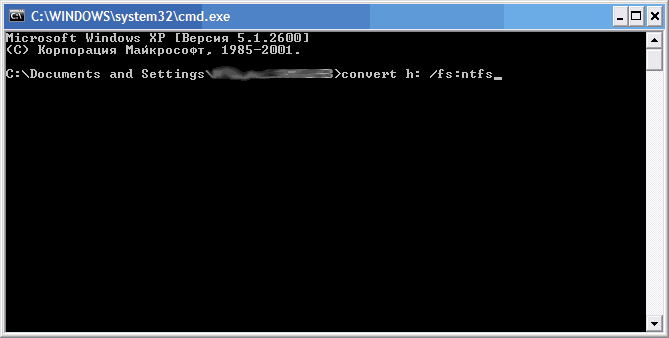
Instead of the letter, insert the letter that you remembered and press "Enter"
In a few seconds, you will have an NTFS flash drive capable of writing files larger than 4 gigabytes.
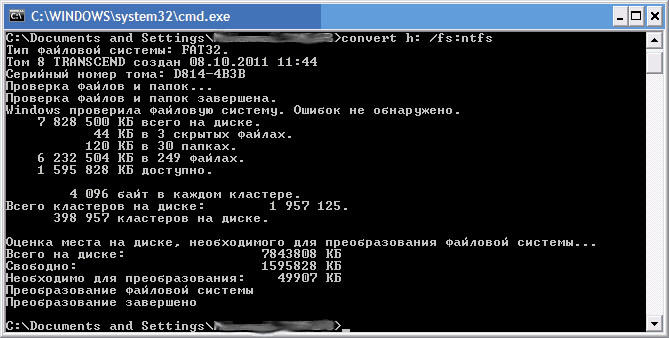
Now you have learned how to format a usb flash drive to ntfs on a windows XP computer.
Any difficulties, write in the comments.

